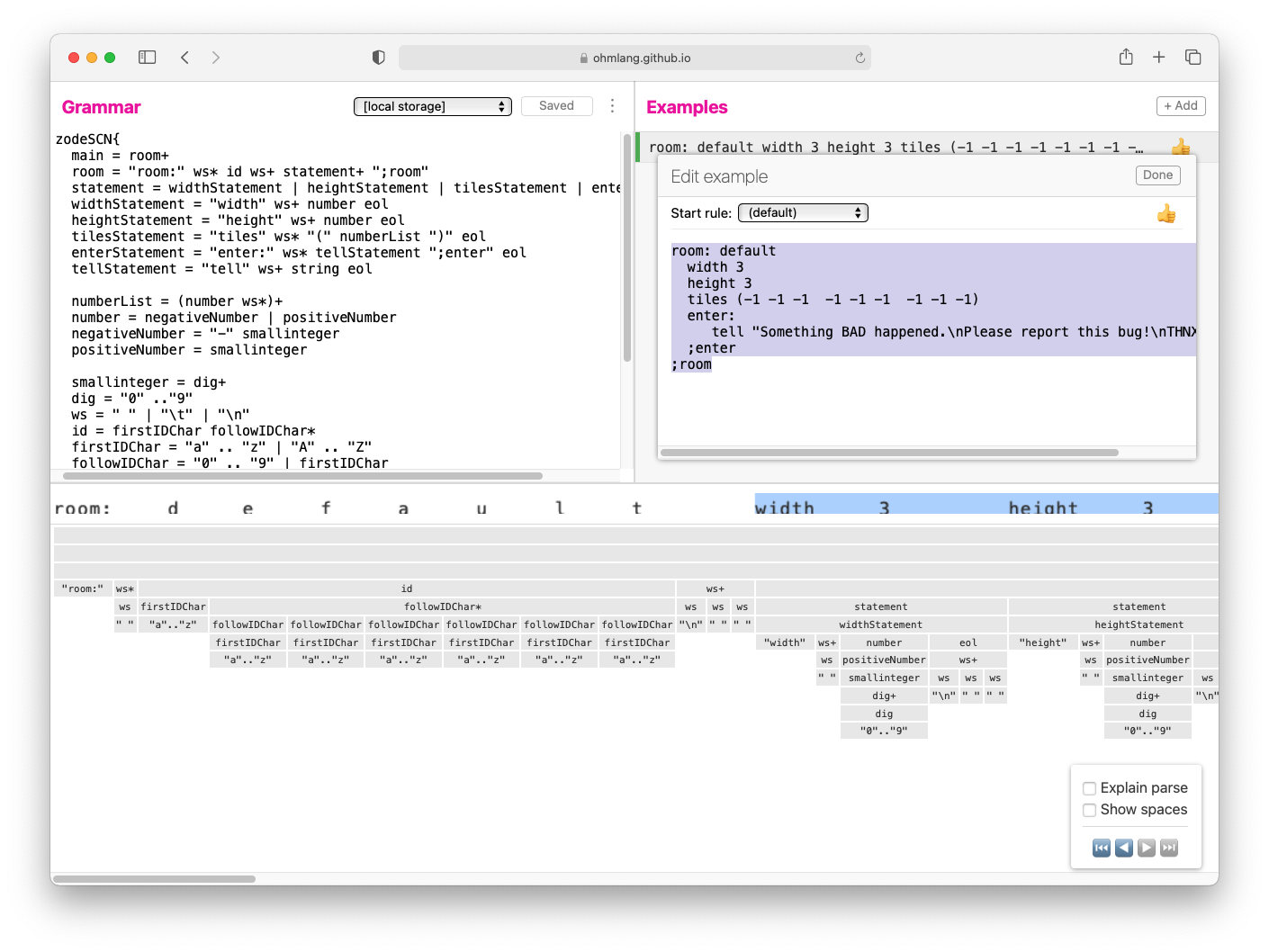SCN Development for ZodeTrip
Introduction
In this note, I show how to develop an SCN (see below - like a DSL) for a game development system.
SCN means Solution Centric Notation. Basically a mini-DSL. See below.
Initial Grammar
zodeSCN{
main = room+
room = "room:" ws* id ws+ statement+ ";room"
statement = widthStatement | heightStatement | tilesStatement | enterStatement
widthStatement = "width" ws+ number eol
heightStatement = "height" ws+ number eol
tilesStatement = "tiles" ws* "(" numberList ")" eol
enterStatement = "enter:" ws* tellStatement ";enter" eol
tellStatement = "tell" ws+ string eol
numberList = (number ws*)+
number = negativeNumber | positiveNumber
negativeNumber = "-" smallinteger
positiveNumber = smallinteger
smallinteger = dig+
dig = "0" .."9"
ws = " " | "\t" | "\n"
id = firstIDChar followIDChar*
firstIDChar = "a" .. "z" | "A" .. "Z"
followIDChar = "0" .. "9" | firstIDChar
string = quote notQuote* quote
quote = "\""
notQuote = ~quote any
eol = ws+
}
Ohm-JS vs Other PEG Libraries
Ohm-JS rule names are case-sensitive.
In Ohm-JS, lower-case rule names work just like other PEGs (modulo minor syntactic differences).
In Ohm-JS, upper-case rule names skip spaces, so most of the ws stuff above could go away.
The other big difference between Ohm-JS and other PEG libraries is how matches are tagged. I will explain this later. Let’s just work on the grammar first.
Initial Test Code
room: default
width 3
height 3
tiles (-1 -1 -1 -1 -1 -1 -1 -1 -1)
enter:
tell "Something BAD happened.\nPlease report this bug!\nTHNX 1.0E6!!!"
;enter
;room
Ohm Editor
 Exercise 1
Exercise 1
Convert the grammar from Ohm-JS style to racket (#peg) style.
Use the same test grammar and make sure that you get the same result.
Gedanken: Do you find Ohm-Editor to be convenient, even when using a different #peg syntax?
Exercise 2
Convert the grammar so that
room:
...
;room
becomes
room
...
end room
Write new test code and test the new grammar.
Exercise 3
Convert
enter:
tell "Something BAD happened.\nPlease report this bug!\nTHNX 1.0E6!!!"
;enter
into
enter
tell "Something BAD happened.\nPlease report this bug!\nTHNX 1.0E6!!!"
end enter
Exercise 4
Gedanken: At present, the id rule will accept keywords like tell, etc.
How would you make a list of keywords and include them in the id rule (hint: using negative lookahead)?
Commentary
Syntaxes are Pattern-Matching Skins
A grammar is a pattern matcher.
Pattern matchers are popular today, often found in FP languages.
Grammars are the mothers of all pattern-matchers.
Treating syntaxes as light-weight skins produces a different, more productive, kind of programming.
PEG technology and cheap/fast CPUs and cheap memory makes it possible to re-think the use of syntax as something light-weight instead of something shrouded in mystery that is accessible only to compiler gurus.
2 Syntaxes
Some languages, like C and Lisp, collapse end room into single characters }and ).
Gedanken: Which style gives more lucid error checking?
Gedanken: Is it harder in the grammar to ask for end room instead of single characters?
Gedanken: Which is more writable?
Gedanken: What if we had 2 syntaxes, one with end room and another with }?
Gedanken: How easy is it to create separate syntaxes, for example to parse the end room syntax and to write it back out in } syntax?
SCN
SCN means Solution Centric Notation. In my vocabulary, a notation is like a mini-DSL.
When I build an SCN, I cheat and let the underlying language (the toolbox language) handle all of the heavy lifting. I use a grammar like a skin instead of as a full-blown programming language.
Lisp (and Scheme, and Racket) makes a great toolbox language.
Assembler is the mother of all toolbox languages.
We don’t want to get our hands dirty with assembler, so we create syntactic skins. [This used to be difficult in the 1950’s, but is easy in the 2020’s.]